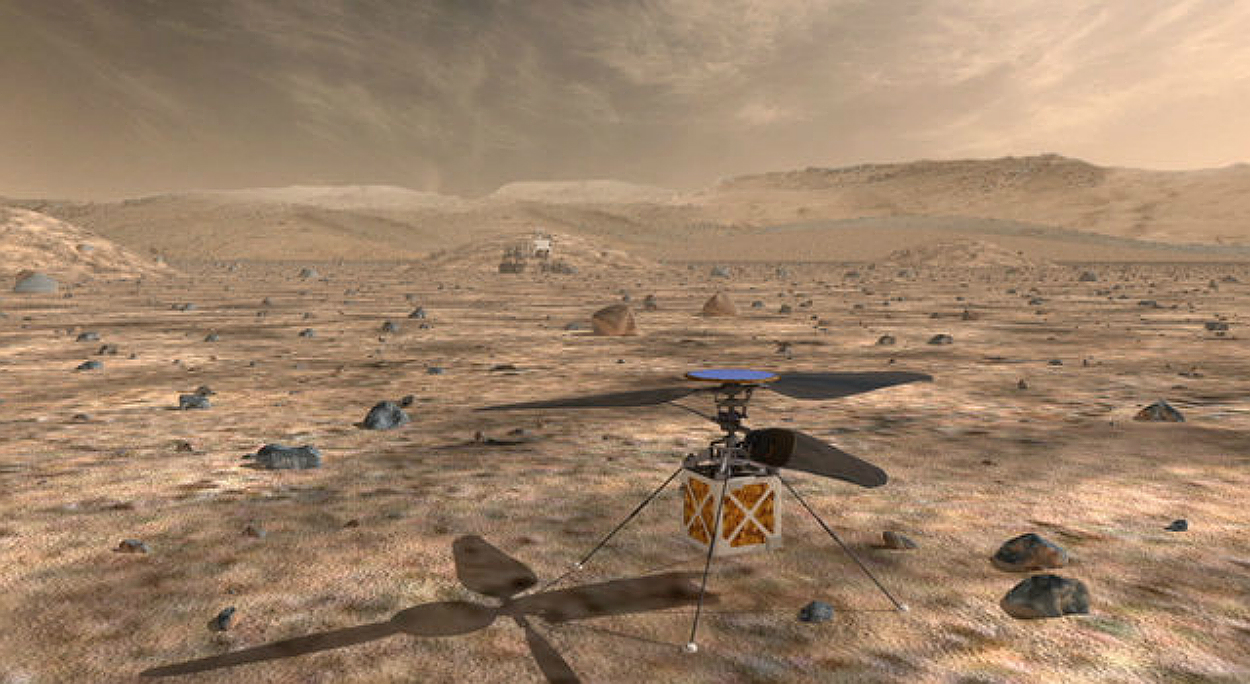 The Mars Helicopter Scout solar powered mini-helicopter can fly in a rarefied atmosphere of Mars for up to three minutes a day for a distance of up to 600 meters
The Mars Helicopter Scout solar powered mini-helicopter can fly in a rarefied atmosphere of Mars for up to three minutes a day for a distance of up to 600 metersAfter a lengthy discussion, the NASA administration
decided to include the 1.8-pound Mars Helicopter Scout (MHS) solar-powered drone helicopter in the Mars 2020 mission.
The complete set of the descent stage “Mars-2020” is already fully known. All
scientific instruments are defined. Only one thing remained unknown - whether to leave the station with a small unmanned helicopter MHS. It seems to be and its weight is small. On the other hand, the drone is not such a big benefit: it can fly no longer than three minutes a day for a distance of up to 600 meters.
But the scout was lucky. He still take to Mars.
“The very idea of a helicopter flying in the sky of another planet is capturing,”
said NASA administrator Jim Bridenstine. “Mars Helicopter has great prospects for scientific and reconnaissance missions.”
Apparently, sending a helicopter to Mars has not only a scientific and research purpose, but carries the task of popularizing science: “The United States is becoming the first country in history that sends an aircraft heavier than air to another world,” said John Culberson. “This exciting and forward-looking achievement will inspire young people across the country to become scientists and engineers, paving the way for even greater discoveries in the future.”
The helicopter was developed in August 2013 at the NASA Jet Propulsion Laboratory (JPL). After four years of design, testing and design, a UAV weighing 1.8 kilograms has been created, its fuselage about the size of a grapefruit.
Double blades rotate in opposite directions at a speed of 3000 revolutions per minute, which is about 10 times faster than helicopters on Earth.
Technological demonstration of the helicopter Mars Helicopter ScoutNASA is now implementing
the ATLO phase , that is, the operations of assembling, testing and launching as part of the Mars 2020 mission. In March, the
electrical connection of the flight equipment to the descent stage of the vehicle , which will land the rover on the Martian surface approximately in February 2021, continued.
The Mars Helicopter Scout helicopter is equipped with solar cells for charging lithium-ion batteries and a heating system for cold Martian nights.
“The record for helicopter flight altitude on Earth is about 40 thousand feet (12,200 meters). The density of the Martian atmosphere is 1% of Earth's, therefore, on the surface of Mars, the density of the atmosphere is equivalent to 30.5 km above the Earth, ”said Mimi Aung, project manager for Mars Helicopter at JPL. “To make it fly at such a low atmospheric density, I had to carefully study everything, lighten the weight as much as possible and increase power to the limit.”
As soon as the rover is on the surface of the planet, a suitable place will be found to lower the helicopter on the ground. Then the rover will drive off to a safe distance, from where it will transmit commands. When the “scout” batteries are charged and the tests are completed, operators from Earth will give a command to the first autonomous flight of a drone on another planet in history.
A full 30-day flight test campaign includes up to five flights with a gradual increase in the distance to several hundred meters and a duration of up to 90 seconds. During the first test flight, a vertical lift of three meters is planned, a hang for 30 seconds and a landing.
Experts believe that such drones have excellent prospects for reconnaissance missions: “The ability to clearly see what is behind the next hill is crucial for future researchers,” said Thomas Zurbuchen, co-administrator of the NASA mission. “We already have beautiful views of Mars from both the surface and the orbit.” With an additional bird's-eye view of the marsokopter, one can only imagine which missions become possible. ”
The Mars 2020 mission is scheduled to launch in July 2020 on board an Atlas V rocket. The rover will conduct a geological assessment of the landing site on Mars, determine the suitability of the environment for human habitation, search for traces of ancient Martian life, assess natural resources and hazards for future researchers. . In addition, with the help of scientific instruments installed on board, scientists plan to identify suitable rock and soil samples. The rover will collect them, sealed in sealed containers and left on the surface of Mars. In future missions, these containers will be found, and then delivered to Earth for more thorough analysis.